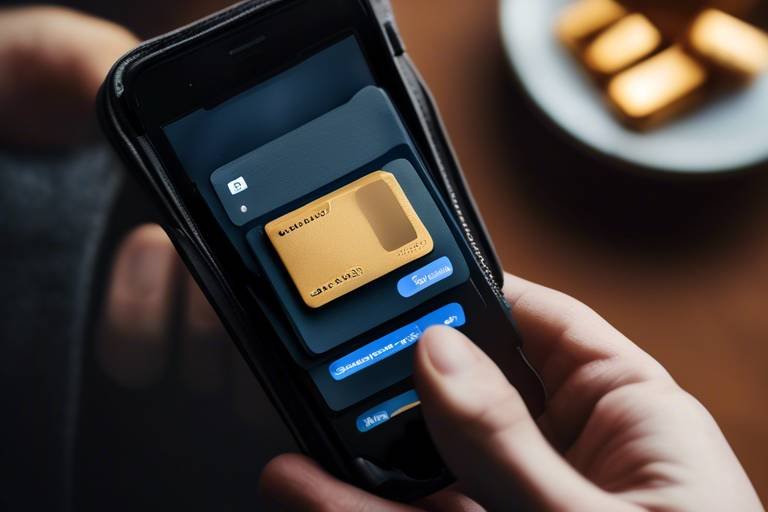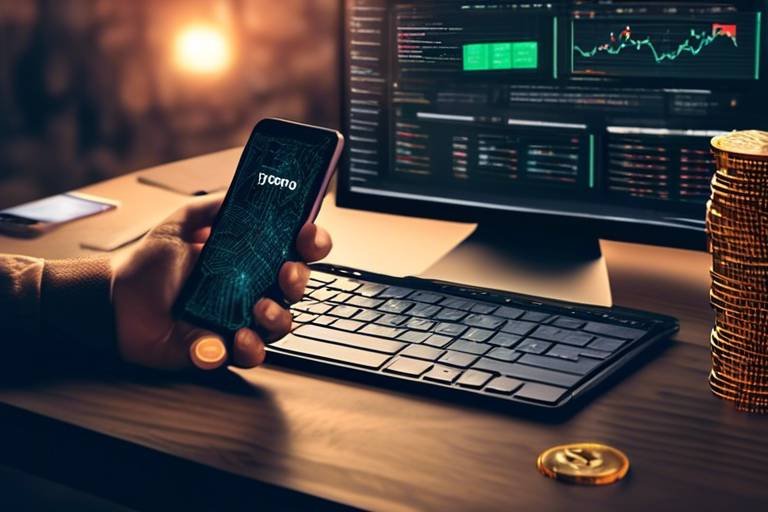How to Avoid Phishing Scams in Crypto Exchanges
In the fast-paced world of cryptocurrency, where fortunes can be made and lost in the blink of an eye, staying protected against phishing scams is more crucial than ever. Phishing scams are not just a nuisance; they can lead to devastating financial losses and a breach of personal information. This article explores effective strategies to protect yourself from phishing scams in cryptocurrency exchanges, ensuring your investments remain secure and your personal information is safeguarded against malicious attacks. By understanding the tactics used by cybercriminals and implementing robust security measures, you can navigate the crypto landscape with confidence.
Phishing scams are deceptive tactics used by cybercriminals to obtain sensitive information such as usernames, passwords, and credit card details. These scams often masquerade as legitimate communications from trusted entities, making them particularly dangerous. In the cryptocurrency world, where transactions are irreversible and anonymity is a double-edged sword, the prevalence of phishing attempts has skyrocketed. According to a recent report, over 60% of crypto investors have encountered phishing attempts at some point. This alarming statistic underscores the need for heightened awareness and proactive measures to protect your assets.
Identifying phishing attempts is crucial for protection. Cybercriminals have become increasingly sophisticated, but there are still telltale signs that can help you discern legitimate communications from fraudulent ones. For instance, if you receive an email claiming to be from your crypto exchange but it contains grammatical errors or a sense of urgency, be wary. Phishing emails often try to create a false sense of urgency, pushing you to act quickly without thinking. Here are some common signs to look out for:
Phishing emails often contain specific red flags that can help you identify them. These include:
- Poor Grammar and Spelling: Legitimate companies usually proofread their communications.
- Suspicious Links: Hover over links to see where they lead before clicking.
- Urgent Calls to Action: Be skeptical of emails that pressure you to act immediately.
Links and attachments in emails can be harmful. Before clicking on any link, always evaluate its safety. Look out for shortened URLs or links that do not match the official website of the exchange. A quick way to check a link is to hover over it; this will display the actual URL. If it looks odd or unfamiliar, do not click! Similarly, attachments can contain malware that can compromise your device. Always be cautious and consider whether you were expecting an attachment.
Verifying the sender's identity is vital in preventing phishing scams. Always check the email address of the sender. Often, phishing emails come from addresses that look similar to legitimate ones but have slight variations. For instance, instead of support@cryptoexchange.com, the email might come from support@cryptoexhange.com. To confirm the legitimacy of an email, you can:
- Contact the company directly through their official website or customer service.
- Look for any previous communications from the same address.
- Use online tools to check the sender's reputation.
Safe browsing practices can significantly reduce the risk of phishing. Always access cryptocurrency exchanges by typing the URL directly into your browser rather than clicking on links from emails or social media. Additionally, ensure that the website is secure by checking for "https://" in the URL. This indicates that the site uses encryption to protect your data. Regularly clearing your browser's cache and cookies can also help in maintaining a secure browsing environment.
Implementing two-factor authentication adds an extra layer of security. This is like having a double lock on your door; even if someone has your password, they won't be able to access your account without the second factor. Enabling 2FA is crucial in protecting your accounts from unauthorized access. Most reputable exchanges offer 2FA options, typically through an authenticator app or SMS codes. Make sure to enable this feature as soon as you create an account.
There are various methods for 2FA, and choosing the right one is essential. Here’s a quick comparison:
| 2FA Method | Security Level | Convenience |
|---|---|---|
| SMS Codes | Medium | High |
| Authenticator Apps | High | Medium |
| Hardware Tokens | Very High | Low |
While SMS codes are convenient, they are not the most secure option due to potential interception. Authenticator apps provide a good balance of security and convenience, while hardware tokens offer the highest level of protection but can be cumbersome to carry around.
Keeping security settings updated is essential. Cyber threats are constantly evolving, and so should your security measures. Regularly reviewing and modifying security settings on crypto exchanges can enhance your protection against emerging threats. This includes changing your passwords frequently, updating your recovery information, and ensuring that your 2FA methods are active and functioning. Remember, your security is only as strong as your last update!
Q: What should I do if I suspect a phishing attempt?
A: If you suspect a phishing attempt, do not click on any links or provide any personal information. Report the email to your crypto exchange and delete it immediately.
Q: Is two-factor authentication really necessary?
A: Yes! Two-factor authentication significantly enhances your account's security by requiring a second form of verification.
Q: How can I tell if a website is secure?
A: Look for "https://" in the URL and a padlock icon in the address bar. This indicates that the website is using encryption to protect your data.

Understanding Phishing Scams
Phishing scams are among the most prevalent and deceptive tactics employed by cybercriminals, particularly in the ever-evolving world of cryptocurrency. At its core, phishing is a method used to trick individuals into revealing sensitive information such as usernames, passwords, and credit card details. These scams can take many forms, including fraudulent emails, fake websites, and deceptive messages that appear to be from legitimate sources. The cryptocurrency landscape, with its rapid growth and often complex nature, has unfortunately become a prime target for these malicious actors.
Why is phishing so rampant in the crypto sphere? The answer lies in the combination of high-value assets and a general lack of awareness among users. Many individuals are still learning the ropes of digital currencies, making them more susceptible to scams. Moreover, the anonymity and irreversibility of cryptocurrency transactions mean that once a scammer has your funds, it can be nearly impossible to retrieve them. This highlights the urgent need for awareness and education around phishing tactics.
It's essential to understand that phishing attempts are not just limited to emails. They can also manifest in various forms, including:
- Malicious websites: Scammers often create websites that mimic legitimate exchanges or wallets, tricking users into entering their credentials.
- Social media scams: Fraudulent accounts on platforms like Twitter and Facebook can promise giveaways or investment opportunities that lead to phishing attempts.
- SMS phishing (smishing): Text messages that appear to be from trusted sources can also be used to lure individuals into providing personal information.
The prevalence of these scams underscores the importance of vigilance. By understanding the tactics employed by scammers, you can arm yourself with the knowledge needed to protect your investments and personal information. Always remember, if something seems too good to be true, it probably is. Staying informed and cautious can make all the difference in keeping your cryptocurrency safe.

Recognizing Phishing Attempts
In the fast-paced world of cryptocurrency, being able to recognize phishing attempts is crucial for safeguarding your investments and personal information. Phishing scams often masquerade as legitimate communications, tricking unsuspecting users into revealing sensitive data. So, how do you spot these digital traps before they ensnare you? By being aware of the common signs of phishing, you can arm yourself with the knowledge needed to navigate the murky waters of online security.
One of the most prevalent methods used by cybercriminals is through phishing emails. These emails often have a sense of urgency, prompting you to act quickly without thinking. For instance, you might receive an email claiming that your account has been compromised, urging you to click a link immediately to secure it. However, before you panic and click, take a moment to scrutinize the email for red flags. Look out for poor grammar, generic greetings, and suspicious URLs that don’t match the official website. If the email looks off, it probably is!
Phishing emails often have specific characteristics that can help you identify them. Here are some common red flags to watch for:
- Unusual Sender Address: If the email comes from a domain that looks strange or slightly altered, it’s a strong indicator of a phishing attempt.
- Urgent Language: Phrases like "Act Now!" or "Immediate Action Required!" are often used to create panic.
- Generic Greetings: Be wary of emails that address you as “Dear Customer” instead of using your name.
Another common tactic is the inclusion of suspicious links and attachments. These can lead you to fake websites designed to harvest your login credentials or install malware on your device. Before clicking on any link, hover over it to see the actual URL. If it doesn’t match the expected domain, don’t click! Additionally, avoid downloading attachments from unknown sources, as they may contain harmful software.
When it comes to links, always remember the adage, “If it looks too good to be true, it probably is.” Cybercriminals often use enticing offers or promotions to lure you into clicking. If you receive an email claiming you’ve won a cryptocurrency giveaway, take a moment to question its legitimacy. Instead of clicking any links, visit the official site directly by typing the URL into your browser. This simple act can save you from falling victim to a scam.
Another essential step in recognizing phishing attempts is verifying the sender’s identity. This can be done in several ways. First, check the email address closely; often, phishing emails will use an address that looks similar to a legitimate one but has slight variations. For example, instead of “support@cryptocurrency.com,” it might come from “support@cryptocurrencye.com.”
You can also look for contact information in the email. Legitimate companies usually provide multiple ways to reach them, including a phone number or support page. If you’re still unsure, don’t hesitate to reach out to the company directly through their official website or customer service number to confirm whether the email was genuine.
In conclusion, recognizing phishing attempts involves a keen eye and a healthy dose of skepticism. By being aware of the common signs, scrutinizing emails for red flags, and verifying senders, you can significantly reduce your risk of falling victim to these scams. Remember, staying informed and cautious is your best defense in the ever-evolving landscape of cryptocurrency.
Q: What should I do if I suspect an email is a phishing attempt?
A: If you suspect an email is a phishing attempt, do not click any links or download attachments. Report the email to your email provider and the relevant company, and delete it immediately.
Q: How can I ensure my cryptocurrency exchange account is secure?
A: Use strong, unique passwords for your accounts, enable two-factor authentication, and regularly review your security settings to ensure they are up to date.
Q: Is it safe to use public Wi-Fi for cryptocurrency transactions?
A: It's best to avoid public Wi-Fi for any sensitive transactions, including cryptocurrency trading. If you must use it, consider using a VPN for an added layer of security.

Email Red Flags
When it comes to protecting your cryptocurrency investments, being able to identify phishing emails is absolutely crucial. These emails are often crafted to look legitimate, but they contain hidden dangers that can compromise your personal information and financial security. So, what should you look out for? Well, there are several red flags that can help you distinguish between a genuine email and a phishing attempt.
First and foremost, pay attention to the sender's email address. Phishing emails often come from addresses that resemble legitimate sources but have slight variations, such as extra characters or misspellings. For example, an email that appears to come from "support@cryptocurrencyexchange.com" might actually be from "support@cryptocurrencyexch4nge.com." Always scrutinize the sender's address before taking any action.
Another common sign of a phishing email is poor grammar and spelling mistakes. Legitimate companies typically have professional standards, so if an email is riddled with typos or awkward phrasing, it's a strong indication that something is off. Cybercriminals may not have the best grasp of the language, which can lead to these glaring errors.
Urgent calls to action are also a major red flag. Phishing emails often create a sense of urgency to pressure you into making quick decisions. Phrases like “Your account will be suspended unless you act now!” are designed to incite panic. Remember, legitimate companies will usually provide ample time for you to respond to any issues regarding your account.
Additionally, be wary of suspicious links and attachments. Phishing emails frequently contain links that lead to fake websites designed to steal your information. Before clicking on any link, hover over it to see the actual URL. If it looks suspicious or doesn’t match the company's official website, don't click it! Similarly, avoid downloading attachments unless you are certain of their legitimacy, as they could contain malware.
Lastly, if you receive an email that requests sensitive information, such as your password or private keys, it’s almost certainly a scam. Legitimate companies will never ask for this information via email. If you’re ever in doubt, it’s best to contact the company directly through their official website or customer service channels to verify the email's authenticity.
In summary, being vigilant about these can significantly reduce your risk of falling victim to phishing scams. Always take a moment to analyze the details before responding to any email related to your cryptocurrency accounts. Remember, when it comes to online security, it’s better to be safe than sorry!
- What should I do if I suspect a phishing email? If you think an email might be a phishing attempt, do not click any links or download attachments. Instead, report it to your email provider and the company that the email claims to be from.
- Can I recover my account if I fall for a phishing scam? If you believe you have provided sensitive information to a phishing scam, immediately change your passwords and contact the company for assistance. They may be able to help secure your account.
- How can I protect myself from phishing attacks? Use two-factor authentication, regularly update your passwords, and stay informed about the latest phishing tactics to enhance your security.

Suspicious Links and Attachments
When it comes to navigating the treacherous waters of cryptocurrency exchanges, one of the most perilous pitfalls is the presence of . Cybercriminals are cunning, often crafting emails that appear legitimate, only to lead you down a rabbit hole of malware and phishing traps. It's essential to develop a keen eye for these digital traps, as they can compromise not just your crypto assets but also your personal information.
First and foremost, always be wary of links that seem out of place. For instance, if an email claims to be from your favorite exchange but the link redirects you to a different website, that’s a glaring red flag. Legitimate companies will always use their official domain. A quick trick is to hover over the link (without clicking!) to see the actual URL. If it looks suspicious or contains strange characters, it’s safer to steer clear.
Attachments are another common vehicle for phishing attacks. They can harbor harmful malware designed to infiltrate your device and access your sensitive data. If you receive an attachment from an unknown sender or even from a known contact that seems unusual, don't open it. Instead, reach out to the sender through a different channel to verify the authenticity of the message. This step could save you from a significant headache down the line.
To help you further understand the risks associated with suspicious links and attachments, here are some common indicators to watch for:
- Unusual URLs: Look for misspellings or extra characters.
- Generic Greetings: Phishing emails often use vague salutations like "Dear Customer."
- Urgent Language: Be cautious of emails that create a sense of urgency, pushing you to act quickly.
In summary, staying vigilant against suspicious links and attachments is a fundamental part of your cybersecurity strategy. By adopting a cautious mindset and employing these best practices, you can significantly reduce your risk of falling victim to phishing scams. Remember, when in doubt, it's always better to verify than to click!
Q: What should I do if I accidentally clicked on a suspicious link?
A: If you suspect you've clicked on a phishing link, immediately disconnect from the internet and run a full antivirus scan on your device. Change any passwords related to accounts that may have been compromised.
Q: How can I recognize a legitimate email from my crypto exchange?
A: Always check the sender's email address for authenticity, look for official branding, and verify any links by hovering over them before clicking. If you're unsure, log into your account directly from the exchange's official website.
Q: Are there tools to help identify phishing attempts?
A: Yes, there are several browser extensions and security software options that can help detect phishing attempts and warn you before you click on harmful links.

Sender Verification
When it comes to protecting yourself from phishing scams, verifying the sender's identity is absolutely crucial. Cybercriminals are becoming increasingly sophisticated, often spoofing legitimate email addresses to trick unsuspecting users. So, how can you ensure that the email you just received is actually from the company it claims to be from? Here are some effective strategies to help you stay one step ahead of potential scammers.
First and foremost, always check the email address carefully. Look beyond the display name, which can be easily manipulated. For instance, an email that appears to come from "support@yourcryptocurrencyexchange.com" might actually be sent from a similar-looking address like "support@yourcryptocurrencyexch4nge.com." This subtle change can easily go unnoticed, but it’s a red flag that should raise your suspicions.
Another effective method is to look for inconsistencies in the email's content. Phishing emails often contain poor grammar, spelling mistakes, or awkward phrasing. Legitimate companies usually have a professional standard for their communications, so if something seems off, it probably is. If the email prompts you to take immediate action, such as clicking a link or providing personal information, it’s wise to pause and reconsider.
Additionally, you can take the extra step of contacting the company directly. If you receive a suspicious email claiming to be from your cryptocurrency exchange, reach out to their official customer support through their verified channels. Do not use any contact information provided in the email itself, as it could lead you to a phishing site. This direct communication can confirm whether the email was legitimate or a scam.
Lastly, consider using tools and software that can help with sender verification. Many email clients have built-in features that can identify phishing attempts, and there are also third-party applications designed to enhance your security. Utilizing these resources can add an extra layer of protection to your online activities.
In conclusion, sender verification is a fundamental step in safeguarding your cryptocurrency investments. By being vigilant and employing these strategies, you can significantly reduce the risk of falling victim to phishing scams. Always remember, if something feels off, trust your instincts and investigate further.
- What should I do if I suspect a phishing email? If you suspect an email is phishing, do not click any links or provide any personal information. Report it to your email provider and the company being impersonated.
- How can I tell if a website is secure? Look for "https://" in the URL and a padlock icon in the address bar. These indicate that the site uses encryption to protect your data.
- Is two-factor authentication enough to protect my account? While 2FA adds an extra layer of security, it's important to combine it with other practices like strong passwords and regular account monitoring.

Safe Browsing Practices
When it comes to navigating the world of cryptocurrency exchanges, practicing safe browsing habits is your first line of defense against phishing scams. Think of the internet as a vast ocean—while there are many treasures to be found, there are also hidden dangers lurking beneath the surface. To keep your investments safe, you need to equip yourself with the right knowledge and tools.
First and foremost, always ensure that you are accessing the official website of your chosen cryptocurrency exchange. This may sound basic, but it’s crucial. Cybercriminals often create look-alike websites that mimic legitimate exchanges to trick unsuspecting users. A simple typo in the URL can lead you to a phishing site. Always double-check the URL in your browser’s address bar before entering any sensitive information.
Another vital practice is to utilize a secure connection. Make sure that the website uses HTTPS rather than just HTTP. The "S" stands for secure, indicating that the data transmitted between your browser and the website is encrypted. You can easily check this by looking for a padlock icon in the address bar. If you don’t see it, think twice before proceeding.
Additionally, consider using a reputable VPN (Virtual Private Network) when accessing cryptocurrency exchanges. A VPN encrypts your internet connection, making it harder for hackers to intercept your data. This is especially important if you are using public Wi-Fi networks, which are notoriously insecure. Imagine trying to have a private conversation in a crowded café; a VPN acts like a soundproof booth, keeping your information safe from prying eyes.
It's also wise to keep your browser and security software up to date. Outdated software can have vulnerabilities that cybercriminals exploit. Regular updates often include patches that fix these security holes, so make it a habit to check for updates frequently. Just like you wouldn’t drive a car with worn-out brakes, don’t browse the internet without the latest security measures in place.
Finally, be cautious about the information you share online. Avoid oversharing on social media, as cybercriminals can use this information to craft targeted phishing attacks. Remember, if something seems too good to be true, it probably is. Always approach unsolicited offers with skepticism and verify their authenticity before clicking any links or providing personal information.
By implementing these safe browsing practices, you can significantly reduce the risk of falling victim to phishing scams in the cryptocurrency world. Just as a sailor learns to read the winds and tides, you too can learn to navigate the digital seas with confidence and security.
Q1: What should I do if I suspect a phishing attempt?
A1: If you suspect a phishing attempt, do not click any links or provide any information. Report the email or message to your email provider and the relevant cryptocurrency exchange. Always verify directly through official channels.
Q2: How can I tell if a website is secure?
A2: Look for the padlock icon in the address bar and ensure the URL starts with "HTTPS". This indicates that the website is using a secure connection.
Q3: Is using public Wi-Fi safe for trading cryptocurrencies?
A3: Using public Wi-Fi can be risky. If you must use it, consider using a VPN to secure your connection and protect your personal information.
Q4: What are the signs of a phishing email?
A4: Common signs include poor grammar, suspicious links, and urgent calls to action. Always scrutinize the sender's email address and look for inconsistencies.

Two-Factor Authentication (2FA)
is a security measure that adds an extra layer of protection to your online accounts, particularly in the realm of cryptocurrency exchanges. Think of it as a double lock on your door; even if someone has the key (your password), they still can’t get in without that second piece of identification. In a world where cyber threats are ever-evolving, implementing 2FA can significantly reduce the risk of unauthorized access to your accounts. It’s not just a nice-to-have feature; it’s becoming a necessity for anyone serious about safeguarding their digital assets.
So, why is 2FA so important? Well, imagine you’ve just created a strong, unique password for your crypto exchange account. You might feel secure, but what if that password is compromised through a data breach or phishing scam? Without 2FA, a hacker could easily access your account and drain your funds. However, with 2FA enabled, even if they manage to get your password, they would still need a second form of verification, such as a code sent to your phone or generated by an app. This makes it much harder for them to succeed.
There are various methods for 2FA, and choosing the right one can be a game-changer for your security. Here’s a quick rundown of the most common options:
- SMS Codes: A code is sent to your mobile number each time you log in. While convenient, SMS can be vulnerable to interception.
- Authenticator Apps: Apps like Google Authenticator or Authy generate time-sensitive codes that you enter during login. This method is more secure than SMS.
- Hardware Tokens: Physical devices that generate codes. They provide a high level of security but can be less convenient.
When selecting a 2FA method, consider your personal needs and the level of security you require. For instance, if you frequently travel and might not always have access to your phone, a hardware token might not be the best choice. On the other hand, if you want the highest level of security, using an authenticator app is generally recommended.
It's also crucial to regularly update your security settings, including your 2FA method. As technology advances, so do the tactics of cybercriminals. By staying proactive and reviewing your security measures, you can adapt to new threats and ensure your crypto investments remain safe. Remember, security is not a one-time task but an ongoing process. Take the time to familiarize yourself with your exchange's security features and make the necessary adjustments to keep your account secure.
Q: What is Two-Factor Authentication (2FA)?
A: 2FA is a security process that requires two different forms of identification to access your account, making it harder for unauthorized users to gain access.
Q: Why should I use 2FA for my crypto accounts?
A: Using 2FA significantly enhances your account's security by requiring an additional verification step, protecting against unauthorized access even if your password is compromised.
Q: What is the best method for 2FA?
A: While SMS codes are convenient, using an authenticator app is generally considered more secure. Hardware tokens offer the highest level of security but can be less convenient.
Q: Can I use 2FA on multiple devices?
A: Yes, most 2FA methods allow you to set them up on multiple devices, but make sure to keep your backup codes in a safe place in case you lose access to your primary device.

Choosing the Right 2FA Method
When it comes to securing your cryptocurrency accounts, two-factor authentication (2FA) is a game changer. But with several methods available, how do you choose the right one? It's like picking the best lock for your front door; you want something that not only fits but also keeps out unwanted visitors. Let’s break down the most popular 2FA methods and help you decide which suits your needs best.
First off, we have SMS codes. This method sends a text message with a verification code to your phone whenever you log in. While convenient, it can be vulnerable to interception or SIM swapping attacks. Imagine someone stealing your phone number and using it to access your accounts! So, while SMS can be a good start, it's not the most secure option out there.
Next, let’s talk about authenticator apps. These apps, like Google Authenticator or Authy, generate time-based codes that you enter after your password. This method is much more secure than SMS because the codes are generated on your device and not sent over the air. Think of it as having a personal bodyguard for your account—always with you and always ready to protect your assets.
For those looking for the highest level of security, hardware tokens are the way to go. These small devices generate codes that you must enter to log in. They are nearly impossible to hack remotely since they are physical items that you must possess. It's like having a vault that requires a special key; even if someone knows your password, they still can’t get in without the key.
So, which method should you choose? Here are some factors to consider:
- Convenience: If you’re always on the go, SMS codes might seem easier, but remember the risks.
- Security: Authenticator apps offer a good balance of security and convenience, while hardware tokens provide the best protection.
- Cost: Most authenticator apps are free, but hardware tokens can come with a price tag.
Ultimately, the right 2FA method for you depends on your personal circumstances. If you’re dealing with significant investments, it’s worth investing in a hardware token. However, if you’re just starting out, an authenticator app is a solid choice. Remember, the goal is to add that extra layer of security to keep your investments safe from prying eyes.

Regularly Updating Security Settings
In the ever-evolving landscape of cybersecurity, keeping your security settings updated is not just a good practice; it's an absolute necessity. Think of your security settings as the locks on your front door. Just as you wouldn’t want to leave your door unlocked because you’re too comfortable in your home, you shouldn’t let your crypto accounts remain vulnerable due to outdated security measures. Regular updates can help you stay one step ahead of potential threats and ensure that your investments remain safe.
So, what does it mean to regularly update your security settings? First and foremost, it involves reviewing your account settings frequently. Most cryptocurrency exchanges offer a variety of security features, such as password strength indicators, recovery options, and alerts for suspicious activity. By regularly checking these settings, you can ensure that you are utilizing every available tool to protect your assets. For instance, if your exchange has introduced new security features, you’ll want to enable them immediately to enhance your defenses.
Moreover, it’s essential to change your passwords regularly. A strong, unique password is your first line of defense against unauthorized access. Consider using a password manager to generate and store complex passwords. This not only makes it easier to maintain different passwords for various accounts but also adds an extra layer of security. Remember, a password that is easy to remember is often easy for hackers to guess!
Another crucial aspect of updating your security settings is to enable notifications for account activity. Most exchanges allow you to receive alerts via email or SMS whenever there is a login attempt or a transaction made. This feature can act as your personal watchdog, alerting you to any suspicious activity before it escalates into a full-blown crisis. The sooner you can react to unauthorized access, the better your chances of mitigating any potential damage.
Finally, don’t underestimate the importance of keeping your software updated. This includes your operating system, browser, and any applications you use for trading. Cybercriminals often exploit vulnerabilities in outdated software to gain access to sensitive information. By ensuring that everything is up-to-date, you’re closing the door on potential entry points for attackers.
In summary, regularly updating your security settings is an integral part of maintaining a secure environment for your cryptocurrency investments. By actively managing your account settings, changing passwords, enabling notifications, and keeping software updated, you can significantly reduce your risk of falling victim to phishing scams and other cyber threats.
- How often should I update my security settings? It’s advisable to review your settings at least once a month or whenever there are significant changes to your exchange or software.
- What should I do if I suspect my account has been compromised? Immediately change your password, enable two-factor authentication, and contact your exchange’s support team.
- Are password managers safe to use? Yes, reputable password managers use strong encryption to keep your passwords secure and can help you create complex passwords that are hard to crack.
Frequently Asked Questions
- What is a phishing scam?
A phishing scam is a deceptive attempt by cybercriminals to obtain sensitive information such as usernames, passwords, and credit card details by masquerading as a trustworthy entity in electronic communications. In the world of cryptocurrency, these scams are particularly prevalent, making it crucial to stay vigilant.
- How can I recognize a phishing email?
Phishing emails often exhibit certain red flags. Look out for poor grammar, generic greetings, and urgent calls to action. Additionally, suspicious links or attachments can indicate a scam. Always verify the sender's email address and be cautious before clicking on any links.
- What should I do if I suspect a phishing attempt?
If you suspect a phishing attempt, do not click on any links or attachments. Instead, report the email to your email provider and delete it. You can also verify the legitimacy of the communication by directly contacting the organization through official channels.
- How does two-factor authentication (2FA) enhance security?
Two-factor authentication adds an extra layer of security by requiring not only a password but also a second form of verification, such as a code sent to your phone. This makes it significantly harder for unauthorized users to access your account, even if they have your password.
- What are the best methods for 2FA?
There are several methods for 2FA, including SMS codes, authenticator apps, and hardware tokens. Authenticator apps are generally considered more secure than SMS codes, as they are less susceptible to interception. Choose the method that best fits your needs and security preferences.
- Why is it important to regularly update security settings?
Regularly updating your security settings is essential because cyber threats are constantly evolving. By reviewing and modifying your security settings, you can better protect your accounts from new vulnerabilities and ensure that your personal information remains secure.



















